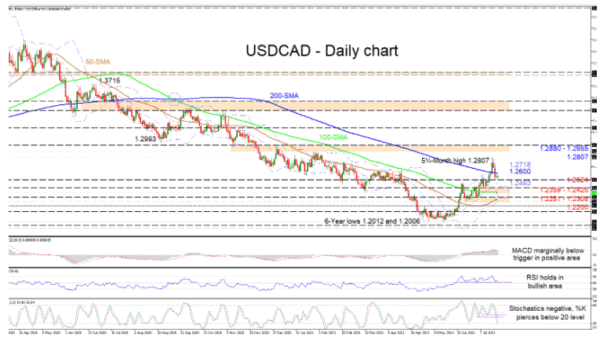USDCAD’s seven-week uptrend from the 6-year lows remains structurally intact with shaped higher lows and highs, in spite of the fresh pullback from the peak of 1.2807. Upside sentiment appears to be growing, something also being indicated by the softened negative slopes of the 100- and 50-day simple moving averages (SMAs). Furthermore, the rising 50-day SMA is steering for a possible bullish crossover of the flattening 100-day SMA, which ultimately could confirm upside improvements should positive price action intensify.
The short-term oscillators are currently mixed however have yet to signal negative forces as the frontrunners. In bullish regions the MACD has slid a tad beneath its red trigger line, while the RSI is trying to sustain its pivot northward prior to reaching the 50 threshold. The negative charge of the stochastic oscillator has yet to show signs of slowing, signalling strong buying interest is still absent.
Trying to preserve the structure of the recent uptrend, buyers may face initial resistance from the capping 200-day SMA at 1.2600. If buyers gather adequate forces and beat the curbing 200-day SMA, they may then propel to test the upper Bollinger band at 1.2718 before revisiting the five-and-a-half-month high, which marginally overstepped the 1.2800 handle. Conquering the 1.2807 peak could reinforce upside tendencies bringing the resistance border of 1.2880-1.2955 quickly into play.
Otherwise, if sellers fuel another pullback, downside friction could commence from the immediate 1.2524 low and the rising mid-Bollinger band, approaching from below at 1.2493. Retracing further, the pair may then meet a support zone from the 1.2425 low until the 100-day SMA at 1.2359. Should this break down, the reinforced base of 1.2251-1.2308 could challenge the descent.
Summarizing, in order to safeguard the positive structure in USDCAD, the price would need to beat the 200-day SMA. Moreover, a push beyond 1.2807 could bolster buyers’ confidence, while a dip below the 1.2200 mark may reinstate power in the bigger bearish bias.













